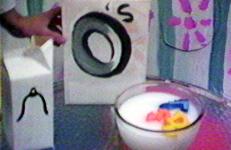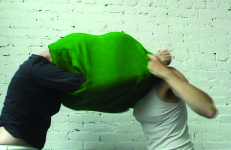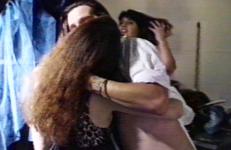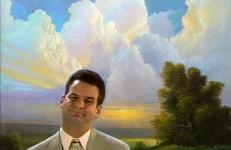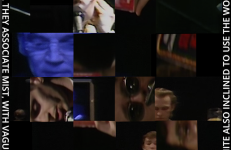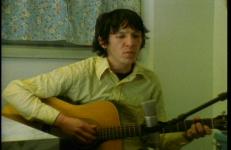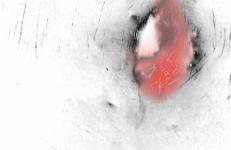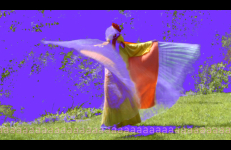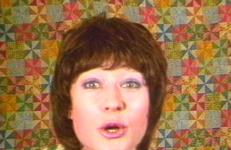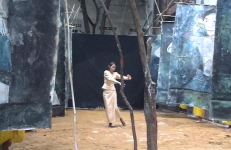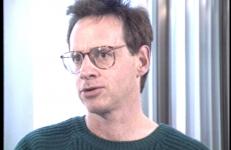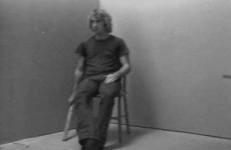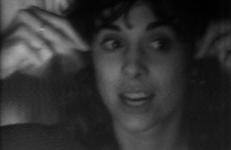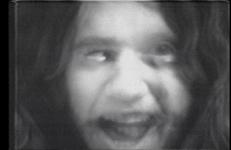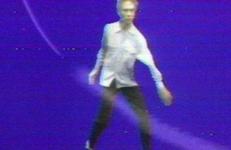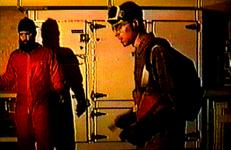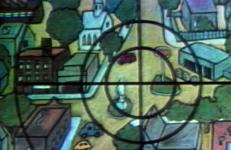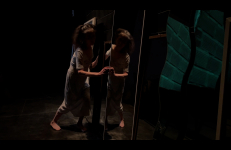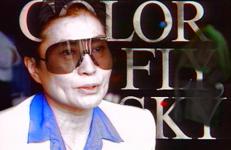Tripping out on loneliness, The Loner drifts through one daydream about “Her” after another. Oursler nightmarishly fantasizes about the dismal prospect of looking for love in a sleazy singles bar. Painfully aware of his lack, the hero is moved by his constant misrecognition of the object of his desire in an adolescent melodrama of sexual obsession and failure. As one of Oursler’s earliest tapes, The Loner is especially crude in its details, with many of the hand-painted sets dissolving under a stream of water.
Performance
The Look of Love: A Gothic Romance is an experimental video/audio collage in four acts. Performing in various guises, Suzie Silver embarks on a quest for the magnificence—and horror—of desire and pleasure. Her female characters are caught up in a cascade of subtle and spectacular cinematic images of sexual desire between women.
Treating the problem of anorexia nervosa from the parents' perspective, Rosler presents a mother and father speaking about the tragedy of their daughter's death as a result of dieting. The conversation turns toward the irony of self-starvation in a land of plenty and toward the international politics of food, where food aid is used as a negotiating tool. Confronting a serious issue, Rosler simultaneously sets into play the confessional form and the ghoulish staginess of talk show dramatics.
A performance by A.K. Burns and Ulrike Müller.
The title is also available on A.K. Burns: Early Videoworks.
Love is in the air as newlyweds chomp on cake, brides marry werewolves, and hatchets fall on adulterous heads. Amid the real-life romance is mixed the real-life business of directing my film students in a tale of run-away passions for the silver screen.
If television is truly the opiate of the masses, then Teddy Dibble is a living room crack dealer. This newly compiled series of television art comedy includes:
1. The Cough, 03:17
2. Secrets I’ll Never Tell, 01:02
3. The Shot Heard Around the World, 00:52
4. Rabbit Rabid Raw Bit, 00:18
5. The Man Who Made Faces, 01:11
6. 11:57 P.M. December 31st, 01:05
7. The Sound of Music, 02:25
A re-reading/ re-construction of a Wooster Group theater production: Part I / LSD: Just the High Points, 1978
An independent film portrait of singer/songwriter Elliott Smith in Portland, Oregon in 1996, wherein he plays three songs. The songs were done live acoustic--in his old studio, a living room, and a bathroom (it was quiet in there). It's also a small portrait of Portland, Oregon.
The songs are "Between the Bars", "Angeles", and a cover of "Thirteen" by Big Star.
This is Elliott as I remember him, at his simple finest as musician.
At Breder's direction in the studio, the performer releases a body of light that casts a transient shadow. Following the tantric chakra stations, a match is lifted from root to crown. Instead of a perfect mirror, Breder filmed the reflection in a dented, scratched piece of polished steel.
This video-lament for Mother Earth is a collaboration among Jim Barbaro, sound; Tobe Carey, cinematography and video editing; and Brenda Hutchinson playing a long tube.
"Made right after Covid lockdown, my art gave me an opportunity to rejoice, grieve and sonically face impermanence via sounds and a Chicken Dance I’ve been performing for decades. The beauty of this video is that it looks like Chicken Linda can finally FLY!! Please interact if you wish and dance, sing, cry, and FLY HIGH."
–– Linda Mary Montano
Combining Rubnitz’s skillful manipulation of the familiar “look” of TV shows with an extraordinary range of characters, performer Ann Magnuson convincingly impersonates the array of female types seen on TV in a typical broadcast day. From glitzy to drab, from friendly housewife to desperate evangelist, Magnuson is a one-woman universe appearing on every channel, the star of every program—giving her all as the chameleon woman who is always on display.
Combining Rubnitz’s skillful manipulation of the familiar “look” of TV shows with an extraordinary range of characters, performer Ann Magnuson convincingly impersonates the array of female types seen on TV in a typical broadcast day. From glitzy to drab, from friendly housewife to desperate evangelist, Magnuson is a one-woman universe appearing on every channel, the star of every program—giving her all as the chameleon woman who is always on display.
Focusing on the mentorship of Eiko and Koma with the young artists who study and work at the Reyum Institute of Arts and Culture in Phnom Penh, Cambodia, Cambodian Stories evokes questions of tradition, innovation, and the role of the artist in fostering social change and discoveries of new ways to leap from the canvas to the stage. Eiko & Koma's collaboration hones in on these young painters' collective energy and explores the challenges they face pursuing artistic careers in a country with little opportunity.
From The Crystal Quilt performance, Suzanne Lacy, Phyllis Jane Rose, Nancy Dennis, Sage Cowles, Minneapolis, 1987.
John Malpede is a performance artist and Director of the Los Angeles Poverty Department (LAPD), a performance art and theater group whose members include the city’s homeless. Through LAPD, Malpede provides an opportunity for homeless people to articulate the reality of their lives for themselves and audiences. Malpede was well known for his collaboration with performer Gill Gordh as Dead Dog and Lonely Horse. In one performance he took on the role of a street person, contrasting the wealth and excess of the 1984 Olympics in Los Angeles with the city’s struggle against homelessness.
"Mama mama mama...," a woman calls out again and again, over and over. Is it her child that she mimics, or is she calling for her own mother? A desperate video performance in the first person.
A distinguished looking man (performance artist Richard Layzell) is apparently trapped in an ever changing void of colour, locked in a power play with a perversely operated camera. A mute, caged, charismatic TV presenter he is by turns charming, menacing, educational, confused. At times he appears to have great powers. A voiceover tells us extraordinary things — how this man is special — the first man to 'have a baby'. Hallucinogenic flash-frames punctuate the colour field to give us a view of his world's disturbing and alien futuristic logic.
“I thought perhaps you’d like to see a demonstration of the new massage chair that we just got in. It — the reason for its — it looks revolutionary, it doesn’t look really like a typical massage chair, and that’s because I think Mies van der Rohe had a part, or at least he was a consultant, to the firm that designed this…”. William Wegman opens the video short titled Massage Chair with this grand statement to describe what looks like an ordinary plastic chair. At first the artist’s head is cut from the frame, but he eventually sits down to “demonstrate” the extraordinary qualities of the chair.
A wonderful and humorous example of early image processing, Parry Teasdale and Carol Vontobel perform to camera as their faces are morphed together, forming an image of one person.
Less than two minutes long, this short tape makes playful and surreal use of video’s editing capabilities. Set to a sped-up version of The Band’s “The Weight” – complete with the falsetto vocals, and accelerated tempo that come with time manipulation on records – is a series of rapid, alternating washes and split-image cuts overlaying and juxtaposing the faces of the freex upon one another. Male faces and female faces fuse, the exact identity of the individuals becoming dissolving into ambiguity.
Merce by Merce by Paik is a two-part tribute to choreographer Merce Cunningham and artist Marcel Duchamp. The first section, “Blue Studio: Five Segments,” is an innovative work of video-dance produced by Merce Cunningham and videomaker Charles Atlas. Cunningham choreographed the dance specifically for the two-dimensional video monitor screen. Atlas uses a variety of video imaging effects, including chromakey, to electronically transport Cunningham’s studio performance into a series of outdoor landscapes. The audio track includes the voices of John Cage and Jasper Johns.
The third installment in the Action Series. Two characters engage Ann Hamilton's Headlands kitchen-space and create temporal resonances. To survive they must break the fast (a midnight snack) and service the meal.
This title is also available on HalfLifers: The Complete History.
Mike Builds a Shelter is a performance comedy with apocalyptic overtones, a narrative extension of Smith's installation Government Approved Home Fallout Shelter/Snack Bar. In this darkly humorous morality play, Smith contrasts Mike's rural adventures in a pastoral landscape with his home fallout shelter. Throughout, the dual narratives are intercut with episodes of Mike's Show on cable, in which Mike's banal domestic activities are eagerly if passively received by living-room TV viewers.
In collaboration with Patricia Herminjard Smith.
This video was filmed during a dress rehearsal of Eiko's performance Shedding on February 8, 2023. This scene is the last section of a longer performance work commissioned by UCLA in which Eiko explored new ways to work with a full-length video she created.
Filmed by Patricia Herminjard Smith.
Edited by Eiko Otake.
Lars Movin presents a video portrait of artists who have radically disrupted our conception of art since the 1960s. A large part of the video was made in Venice in 1990, when many of the original Fluxus artists met to hold a large exhibition in connection with the Biennale. The tape includes interviews with most of the leading Fluxus artists, documentation of their works, and clips from videos and films made during the 30 years of this ungovernable art form.




